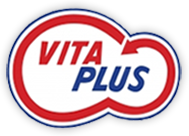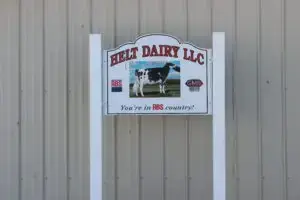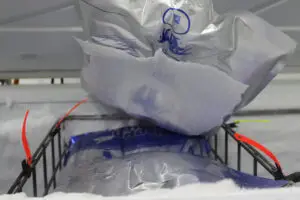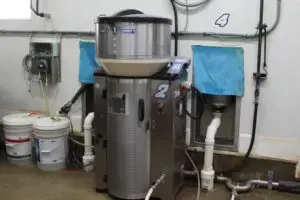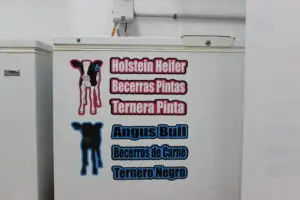
Virtual Farm Tour: Communication is key at Helt Dairy LLC
In 1960, Gilbert and Carol Helt purchased a farm in Dane, Wisconsin, and started milking 30 cows. Gilbert’s son, Dale, and his wife, Diane, purchased the farm in the late 1980s and updated the milking parlor in 1999.
On the same land today sits Helt Dairy LLC, established in 2014 and operated by the third generation of the Helt family. The family currently milks approximately 1,100 cows, raise calves and grow crops.
Dean Helt and his wife, Lauren, are part of the third generation that currently operates Helt Dairy LLC along with his two brothers and their wives: Devin and Amber Helt and Derek and Amanda Helt. Dale and Diane are still involved in the day-to-day operations.
“It is truly a family affair,” Dean remarked.
While everyone in the family may have distinct areas of the operation they oversee, everyone is involved in every aspect of the farm.
“With upgrading equipment and more employees on the farm, my family has been able to create a better work-life balance,” Dean remarked. “It has helped immensely with our time management and efficiency.”
Dean currently heads up the calf program. From day one, he prioritizes quality care and creating the best environment for calves. The Helts raise Holstein heifers and beef-on-dairy Angus-Holstein crossbred bull calves. They utilize sexed semen from ABS Global in the top half of their Holstein herd to produce Holstein heifers and use conventional beef semen to produce beef calves.
Calf philosophy: Colostrum is key
As soon as the newborn calves are dry, they are placed in individual background pens. They receive 4 liters of pasteurized colostrum one hour after birth and receive 2 additional liters four to eight hours after birth. The Helts have found that the second colostrum feeding has improved overall calf performance.
In the calf kitchen, Dean has created a specific protocol for feeding colostrum. A member of the Helt family feeds new calves about 85% of the time. When a family member or employee walks into the kitchen, different labels and instructions are set out so anyone can feed a newborn calf. Each label is in English and two dialects of Spanish, providing resources employees need during the day or night shift.
“Harvesting colostrum is one of the most important things we do,” Dean remarked. “We test all of our colostrum with the Brix refractometer, and feed colostrum that is 23% Brix score and above.”
Fresh colostrum is pasteurized before it’s placed in the freezer. When a calf is born, the bag is taken from the freezer and rewarmed in the Matilda®. Before receiving its colostrum feeding, the calf is weighed. Each calf will get weighed again at weaning to keep track of weight gain.
Calves are closely managed for a 10-day period after birth in individual backgrounding pens. The Helts use this method to get past potential newborn scour episodes. All beef heifer calves and, depending on inventories, some beef bull calves are sold within a week after birth.
In the pen, a calf is bottle-fed pasteurized milk that is supplemented with Vita Plus Calf Magnify. After each feeding, bottles and nipple attachments are sanitized with a chlorine dioxide spray and dried.
Autofeeders and rail feeding for optimal growth
After the 10-day period in individual pens, Holstein heifer calves are moved into an autofeeder pen. With five autofeeder pens, the Helts try to keep fewer than 20 calves in each pen. Calves stay on the autofeeder for 45 days.
In the autofeeder pens, calves continue to receive pasteurized milk with Vita Plus Calf Magnify. The Helts were early adopters of autofeeders. When they upgraded the machines two years ago, one significant improvement over the old machine was that they could use an acid-base wash.
“We try to be aggressive with our autofeeder maintenance,” Dean remarked.
Autofeeder circuits get cleaned once a day. Lines are replaced every four months, and the valve kit is replaced every six months. Nipples are rotated out and washed daily.
Beef calves are moved into a separate small pen and get bottle-fed pasteurized milk each day with a rail feeder.
“With the right equipment, the headlocks are efficient for feeding, tracking consumption and provide flexibility to do other things during feedings,” Dean said.
All calves have 24-hour access to feed and water when they are moved into the small pen. They are introduced to a texturized calf starter. Calves take about three days to get acclimated to feed and water.
A low stress weaning process
After 45 days on the autofeeder, calves no longer receive milk. Fifteen days prior, calves start the gradual weaning process to reduce stress. For beef calves, the weaning process takes four days.
In the winter, calving is slower, so they can keep calves in the same pen five to 10 days after weaning before they move into their initial transition pen. During this time, they receive the same texturized calf starter and water.
After they are weaned, Holstein heifer and beef calves move into respective pens based on size and age. As calves continue to grow, they are transitioned to subsequent pens every 10 to 12 days.
Calves are fed a texturized calf starter until 85 days old. Then, they are introduced to a complete calf pellet and later a dry hay is added.
“We also use a mini-truck and pull wagon when feeding across the farm,” Dean remarked. “This is not only safer for feed delivery in the winter, but efficient.”
Communication is crucial
With multiple employees on farm who speak different dialects of Spanish, the family has learned how to communicate with employees about farm protocols. The operation holds monthly meetings for employees with the translator present to go over a specific topic.
“We review things like calving, milking and equipment,” Dean said. “There are aspects of the operation that change constantly, so these meetings are important.”
The Helts value every employee on their operation. Each of them has a critical role.
“I teach my employees to put themselves in the calves’ shoes,” Dean said. “In everything we do, that is the philosophy.”
“Without their hard work and dedication, Helt Dairy would not be here today,” is inscribed on the memorial rock for Gilbert and Carol Helt that sits on the farm. As Dean reflected on where the operation started and where it is today, he is proud of the foundation his family has been able to build upon, and excited about the future of his family’s farming business.
| Category: |
Autofeeders Calf and heifer nutrition Facility design Farm tours Starting Strong - Calf Care Winter calf care |
